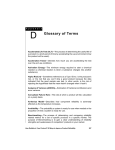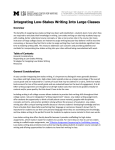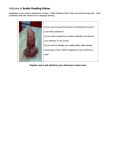Download Opportunity Analysis: “Panning for Gold”
Transcript
Reliability Center, Inc. www.Reliability.com 804-458-0645 [email protected] Opportunity Analysis: “Panning for Gold” Robert J. Latino, CEO, RCI Abstract: Oftentimes people learn new methodologies and employ tools to support those methodologies. However they are disappointed with their bottom-line results. Root Cause Analysis (RCA) is a prime example of this. People usually leave new RCA training pumped up and ready to set the world on fire when they return, but they are usually faced with the “status-quo” when they get back and their new learning is rarely ever used. The other problem is that if they are able to use their new RCA knowledge, they tend to use it like a “”hammer” and treat all problems as “nails”. When one is using RCA properly on every problem that crops up, it is usually overkill and an extremely inefficient process. In this paper we will strive to help the analyst focus on the qualified candidates for RCA, or the real opportunities. Wouldn't it be great if you knew exactly what all of those costly chronic (repetitive) failures were actually costing your facility? There is a way. It is called Opportunity Analysis or OA for short. A similar process called Failure Modes and Effects Analysis (or FMEA) was a technique first developed and utilized in the aerospace industry to find problems with an aircraft design (before it ever left the ground). In short, it is a way of looking into the future and determining the criticality (probability x severity) of potential failure modes in specific system. This sounds wonderful in theory but it takes a tremendous amount of time and energy to do this (sometimes as much as 50 - 100 man years). Realizing that we just do not have that much time or resources in our manufacturing plants, we had to devise a way to make the process less cumbersome. The Opportunity Analysis or OA approach makes one simple change to the FMEA process. Instead of looking into the future, we are going to take a look at our past failures. This changes the time to conduct such analyses from man-years to man-weeks. This makes the process much more practical to use in our facilities. The OA process is used to determine what failures are occurring, in our facility, and what their impact and frequencies are. Think of it this way: Failure Event Failure Mode Frequency/ Impact/ Year Occurrence Failure of pump p-1002 Bearing failure 12 failure/yr. $2,000/failure Sample Failure Event Total Annual Loss $24,000 This simplified table demonstrates the power of this technique. Imagine performing the above calculation for every failure event in your facility. I can assure you that the results would be astounding. Of course, we do not want to work on every failure event, so we need to determine which failure events are the most significant. It just so happens that, typically 20% or less of the failure events represent 80% or more of our losses. This means that we do not have to do Root Cause Analysis (RCA) on everything, just the ones that are "most" important. Let's take a look at the steps involved in performing an OA: # Steps Description 1.00 Perform preparatory work Develop a failure definition, contact flow diagram, gap analysis and preliminary worksheet and interview schedule. © Reliability Center, Inc. 1 2.00 Collect data 3.00 4.00 5.00 6.00 7.00 Interview facility personnel to determine what the failures are, their frequencies and their impacts. Summarize & encode Input into an electronic spreadsheet and determine any results redundancies. Calculate loss Multiply frequency times impact for every failure event in the analysis. Determine "Significant Determine the 20% or less of the failures that result in Few" 80% of the losses. Validate results Verify that the results are valid. Issue a report Communicate results . Steps to perform an Opportunity Analysis Step 1 - Perform preparatory work Before beginning any analysis, it is important to do some preliminary prep work. This analysis is no different. The first thing that needs to be accomplished is to select a system to analyze. For instance, we may want to select a small subset of the facility, as opposed to selecting the entire facility, as our system. Once we know what system we want to work on, we must DEFINE FAILURE AND/OR LOSS. This may seem trivial, but it is an essential step in the analysis. If we were to ask 100 people to define failure, we would probably get 100 different definitions. This would make our analysis far too broad. We need to focus, not on everything, but on the things that are most important to our business at that point in time. For instance, if utilization is critical to our business today, we should center our definition around utilization; if our priority issue is quality than our definition should center on quality. Let's take a look at some examples of common failure definitions: 1. 2. 3. 4. 5. 6. Failure is any loss that interrupts the continuity of maximum quality production Failure is a loss of asset availability Failure is the unavailability of equipment Failure is a deviation from the status quo Failure is not meeting target expectations Failure is any secondary defect The definitions above are some common industrial failure definitions. Please note that there are no perfect failure definitions. For instance, "Failure is any loss that interrupts the continuity of maximum quality production" has to include planned shutdowns, rate reductions for decreased sales, etc. It would not pick up failures on equipment that is spared since it does not interrupt the continuity of production. A precise failure definition is important since it focuses the facility on the priority issues. It fosters good communications since everyone knows what is important and it also provides a basis for a common understanding of what the facility's needs are. Not to mention, it is an essential step in the development of a "Significant Few" failure list. There are few rules-of-thumb to consider when developing a failure definition. It must be concise and easily understandable. If it is not, it will leave too much room for interpretation. It should not have to be interpreted. It must only address one focus. If we include too many topics our target becomes too large. Finally, it should be approved and signed by someone in authority so that everyone in the organization sees that it is a priority issue. © Reliability Center, Inc. 2 The next step in the preparation process is to develop a contact flow diagram (used synonymously with process flow diagram). The contact flow diagram will allow you to break down your system into smaller, more manageable subsystems. The rule for this diagram is to map all of the process units that come into contact with the product. This diagram, as well as the failure definition, will be used when we begin to collect the data for the analysis. Below is a sample of what a global contact flow diagram might look like in a simple refinery. The next thing we need to accomplish before we begin our OA is to perform a gap analysis. In other words, we need to uncover the disparity between what we are producing now and what is our potential. This will give us some indication as to the potential opportunity in our facility. For instance, we produce widgets in our facility, and we currently produce 150,000 per year. However, our potential is 300,000 per year. Now we have a gap of 150,000 widgets per year. The final step in the preparation stage is to design a preliminary interview sheet and a schedule of people to interview to collect the data. This will be the form to assist you in collecting the data from your interviews. To put this all into perspective, the following is a checklist of items to be covered prior to beginning an OA. OA Preparatory Steps Completed (Y/N) Define the system to analyze Define failure Draw a contact diagram Calculate the gap Develop data worksheets Develop preliminary interview schedule OA preparation checklist Step 2 - Collect the Data There are a couple of ways of collecting the data for this analysis. You can rely on your computer data systems (i.e. Computerized Maintenance Management System [CMMS]) or you can go to the people who are closest to the work and get their input. Although each has its advantages, interviewing is probably the best since the information will be coming straight from the source. If you have enough confidence in your data systems, then it will be useful to use that information to later validate your interviews. At this point let's discuss how you would use interviews to collect the data for your analysis. The process is really quite simple. Let's look at a simple scenario: © Reliability Center, Inc. 3 You send out a message to all of the people that you would like to interview. You state the date, time and a brief description of the OA process for the interviewees. Note: it is important to interview at least 2 or 3 people in each session so that the interviewees can bounce ideas off of each other. Once in the room, you will need to display a large copy of the contact flow diagram and the failure definition so that they are in clear view of the interviewees. Now you will begin the process of asking your questions. There really is only one initiating question that needs to be asked; "What events or conditions satisfy the definition of failure within each of the subsystems in the contact flow diagram?". At this point the interviewees will begin to brainstorm all of the failure events that they have experienced within each of the subsystems. Once you have exhausted all of the possibilities, ask the interviewees what the frequency and impact is, on each of the failure events. The frequency should be based on the number of occurrences per year. The interviewees, however, will give you the information in the measurement units that make most sense to them. For instance, they may say it happens once per shift. It is your job to later extrapolate that figure into the number of occurrences per year. The impact should include items such as manpower requirements, material costs and any downtime that might have been experienced. This is all there is to it! When you begin the interview process, it is best to interview the people who are closest to the work (i.e. mechanics and operators). You should also talk with supervisors and possibly managers but certainly not to the extent that you would for mechanics and operators. As a Principal Analyst (PA), you will also need to be the principal interviewer. This means that you have to explain the process to the interviewees, ask the questions and capture the information on your log sheet. This can be a difficult job. If it is feasible, it would be advantageous to have an associate interviewer to assist you by recording the information on the log sheets. This allows you to focus on the questions and the interviewees. The job of interviewing can be quite an experience, particularly if you do not have a lot of experience in conducting them. It tends to be more of an art form than a science. Below is a listing of some tips that may be useful when you begin to conduct your OA interviews. Interview Hints 1. Be very careful to ask the exact same lead questions to each of the interviewees. This will eliminate the possibility of having different answers depending on the interpretation of the question. Later you can expand on the questions, if further clarification is necessary. 2. Make sure that the participants know what an OA is as well as the purpose and structure of the interviews. If you are not careful, the process may begin to look more like an interrogation than an interview to the interviewees. You want the interviewees to be comfortable. 3. Allow the interviewees to see what you are writing. This will set them at ease since they can see that the information they are providing is being recorded correctly. NEVER use a tape recorder in a OA session because it tends to make people uncomfortable and less likely to share information. 4. Never argue with an interviewee. Even if you do not agree with the person, it is best to accept what they are saying at face value and double check it with the information from other interviews. © Reliability Center, Inc. 4 5. 6. 7. 8. 9. The minute you become argumentative, it reduces the amount of information that you can get from that person (and others). Always be aware of interviewee’s names. There is nothing sweeter to a person’s ear than the sound of their own name (remember Dale Carnegie). If you have trouble remembering, simply write the names down in front of you so that you can always refer to them. It is important to develop a strategy to draw out quiet participants. There are many quiet people in our workforce who have a wealth of data to share but are not comfortable sharing it with others. We have to make sure that we draw out these quiet interviewees in a gentle and inquiring manner. Be aware of the body language of interviewees. There is an entire science behind body language. It is not important that you become an expert in this area. However, it is important to know that a substantial portion of human communication (~ 55% - 60%) is through body language. Let the body language talk to you. In any set of interviews, there will be a number of people who are able to contribute more to the process than the others. It is important to make a note of the extraordinary contributors so that they can assist you later in the analysis. They will be extremely helpful if you need additional information, for validating your finished OA, as well as assisting you when you begin your actual Root Cause Analysis (RCA). Remember to use your failure definition and block diagram to keep interviewees on track if they begin to wander off of the subject. Step 3 - Summarize & Encode At this point we have conducted a series of separate interviews and we need to look through our data to filter out redundant entries. Then we convert frequencies from the interviewee’s measurement units into occurrences per year (i.e. 2/month would translate into 24/year). The easiest way to summarize this information is to input the information into an electronic spreadsheet. There are many off-the-shelf products on the market that you could use to conduct these analyses. Once the information is input, you can use your spreadsheet to sort the raw data first by sub-system and then by failure event. This will give you a closer look at the events that are redundant. As far as making the conversions to numbers of times per year, your more advanced spreadsheets can do many of these tasks for you. Consult your user’s manual for creating lookup tables. The following example should give you an idea of what is meant by summarizing your data: SubSystem Recovery Recovery Recovery Recovery Failure Event Failure Mode Recirculation Pump Fails Recirculation Pump Fails Recirculation Pump Fails Recirculation Pump Fails Bearing Fails Frequency/Yr Impact/ Occurrence 1 per month 1 shift Oil Contamination 1 per 2 months 1 day Bearing Locks Up 1 per month Bearing Seizes, Fractures 1 per year Shaft 12 hours 5 days This data suggests that the first three items are the same since they each impact the bearings and have fairly consistent frequencies and impacts. The last item is also related to bearings but went one step beyond the others © Reliability Center, Inc. 5 since we not only lost the bearings but we also suffered a fractured shaft. This would indicate a separate mode of failure. A summarization of this data might look something like this: SubSystem Recovery Recovery Failure Event Failure Mode Frequency/Yr Impact/ Occurrence 12 per year 12 hours Recirculation Pump Bearing Problems Fails Recirculation Pump Bearing Seizes, Fractures 1 per year Fails Shaft Completed OA failure event summarization 5 days Step 4 - Calculate Loss At this point, we want to do a simple calculation to generate our total loss for each event in the analysis. The calculation is as follows: Frequency x Loss per Occurrence (Impact) = Total Loss per Year Let's look at an example of just how to apply this: Total Annual Loss Failure Mode Frequency/ Impact/ Yr Occurrence (hrs/yr) Recirculation Bearing Fails 12 per year 12 lost hrs. 144 lost hrs. of Pump Fails prod. Compressor Seal Failure Blown Seals 4 per year 24 lost hrs. 96 lost hrs. of prod. Mixers Filter Switches Filters Clogged 26 per year 2 lost hrs. 52 lost hrs. of prod. Vent Pressure Gauge Leaks Due To .33 per year 24 lost hrs. 8 lost hrs. of prod. Condensers Leaks Corrosion Completed Loss Calculation Example SubSystem Recovery Failure Event What we need to do is multiply the frequency times the impact to get our total loss. In the first event, we have a failure occurring once per month or 12 times per year. We lose a total of 12 hours production every time this occurs. So we simply multiply 12 occurrences times 12 hours of lost production to get a total loss of 144 hours per year. If you decide to use an electronic spreadsheet all of these calculations can be performed automatically by multiplying the frequency and impact columns. Refer to the section in your software's user manual that concerns multiplying columns. It is important to make sure that total loss is communicated in the most appropriate units. For example, we used hours of downtime per year in the example above. Hours of downtime might not mean much too some people. So it might be more advantageous to convert that number from hours per year to dollars per year since everyone can relate to dollars. In other words, use the units that will get the most attention from everyone involved. Step 5 - Determining the "Significant Few" The concept of the "Significant Few" is derived from a famous Italian Economist name Vilfredo Pareto. Pareto stated that "In any set or collection of objects, ideas, people and events, a FEW within the sets or collections are MORE SIGNIFICANT than the remaining majority". Consider these examples: © Reliability Center, Inc. 6 80% of a bank's assets are representative of 20% or less of its customers 80% of the care given in a hospital is received by 20% or less of its patients Well it is no different in industry. 80% of the losses in a manufacturing facility are represented by 20% or less of its failure events. This means that we only have to perform root cause failure analysis on 20% or less of our failure events to reduce or eliminate 80% of our facilities losses. Now that is significant!!! In order to determine the significant few you must perform a few simple steps: 1. Total all of the failure events in the analysis to create a global total loss. 2. Sort the total column in descending order (i.e. highest to lowest) 3. Multiply the global total loss column by 80% or .80. This will give you the "Significant Few" loss figure that you will need to determine what the "Significant Few" failures are in your facility. 4. Go to the top of the total loss column and begin adding the top events from top to bottom. When the sum of these losses is equal to or greater than the "Significant Few" loss figure than those events are your "Significant Few" failure events. Let's take a look at how this applies to our discussion on OA. Sub System Failure Event Failure Mode Sub System 3 Sub System 2 Sub System 4 Sub System 2 Sub System 3 Sub System 2 Sub System 3 Sub System 3 Sub System 4 Sub System 3 Sub System 1 Sub System 2 Sub System 1 Sub System 2 Sub System 1 Sub System 3 Sub System 2 Total Global Loss Significant Few Losses Failure Event 1 Failure Event 2 Failure Event 3 Failure Event 4 Failure Event 5 Failure Event 6 Failure Event 7 Failure Event 8 Failure Event 9 Failure Event 10 Failure Event 11 Failure Event 12 Failure Event 13 Failure Event 14 Failure Event 15 Failure Event 16 Failure Event 17 Failure Mode 1 Failure Mode 2 Failure Mode 3 Failure Mode 4 Failure Mode 5 Failure Mode 6 Failure Mode 7 Failure Mode 8 Failure Mode 9 Failure Mode 10 Failure Mode 11 Failure Mode 12 Failure Mode 13 Failure Mode 14 Failure Mode 15 Failure Mode 16 Failure Mode 17 Freq/ Yr Impact/ Occurrence 2000.00 $850 1000.00 $1,250 4.00 $75,000 18.00 $6,000 6.00 $12,000 52.00 $1,000 80.00 $500 12.00 $3,000 365.00 $75 24.00 $1,000 12.00 $1,300 40.00 $300 12.00 $1,000 10.00 $1,000 48.00 $200 3.00 $2,000 6.00 $1,000 Total Annual Loss $1,700,000 $1,250,000 $300,000 $108,000 $72,000 $52,000 $40,000 $36,000 $27,375 $24,000 $15,600 $12,000 $12,000 $10,000 $9,600 $6,000 $6,000 $3,680,575 $2,944,460 In the example above, we have totaled the loss column and have a total global loss of $3,680,575. The total loss column has been sorted in descending order so that it is easy to identify the "Significant" failure events. Our "Significant Few" loss figure that we are looking for is $2,944,460 ($3,680,575 x .80). Now all we have to do is simply go to the top of the total loss column and begin adding from top to bottom until we reach the "Significant Few" loss figure of $2,944,460. It turns out that the first 2 failure events represent approximately 80% of our losses ($2,950,000 ) or our "Significant Few" failure list. Now, instead of doing Root Cause © Reliability Center, Inc. 7 Analysis on everything, we are only going to do it on the ones in our "Significant Few" failure list. We could also look at our data in chart form, to see graphically what the "Significant Few" failures represent compared to the rest of the failures. Typical results of a modified OA Step 6 - Validate Your Results There are a few validations that should be performed to make sure that our analysis is correct. You can use the gap analysis to make sure that all of the events add up to +/- 10% of the gap. If it ends up being less, you have probably left some important failure events off the listing. If you have more than the gap then you probably have not summarized your results well enough. There may be some redundancies in your list. A second validation that you can use is having a group of experienced people from your facility review your findings. This will help ensure that you are not too far off base. A third, and final, validation would be to use your computerized data systems to see if the events closely match the data in your maintenance management system. This will give you further confidence in your analysis. Do not worry if your list varies from your Computerized Maintenance Management System (CMMS), since you will pick a lot of events that are never even recorded in the work order system (i.e. those events that may take only a few minutes to repair). Step 7 - Issue a Report As with any analysis, it is important to communicate your findings to all interested parties. Your report should include the following items: 1. 2. 3. 4. 5. 6. An explanation of the analysis technique. The failure definition that was utilized. The contact flow diagram that was utilized. The results displayed graphically as well as the supporting spreadsheet lists. Recommendations of which failures are candidates for Root Cause Analysis. A listing of everyone involved in the analysis including all of the interviewees. Last, but not least, make sure that you communicate the results of the analysis back to the interviewees who participated, so that everyone can feel a sense of accomplishment and ownership. In summary, OA is a fantastic tool for limiting your analysis work to only those things that are of significant importance to the facility. You cannot afford to perform Root Cause Analysis on everything. However, you can use this tool to help narrow your focus to what is "most" important to conduct an RCA. © Reliability Center, Inc. 8 Robert J. Latino is CEO of Reliability Center, Inc. Mr. Latino is a practitioner of root cause analysis in the field with his clientele as well as an educator. Mr. Latino is an author of RCI's Root Cause Analysis Methods© training and co-author of Basic Failure Analysis Methods© workshop. Mr. Latino has been published in numerous trade magazines on the topic of root cause analysis as well as a frequent speaker on the topic at trade shows and conferences. His most recent publication is titled "Root Cause Analysis - Improving Performance for Bottom Line Results" He can be contacted at 804/458-0645 or [email protected]. © Reliability Center, Inc. 9















